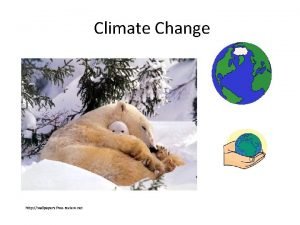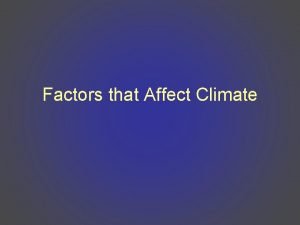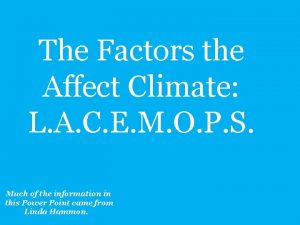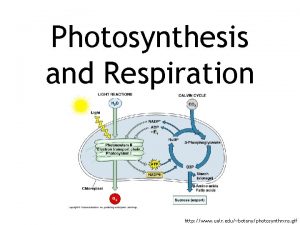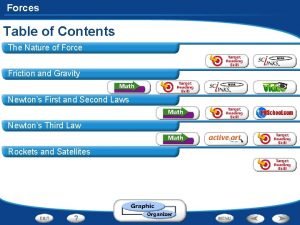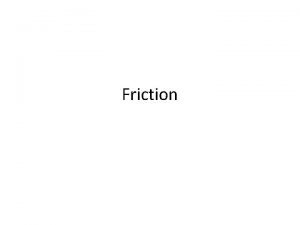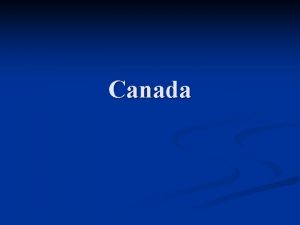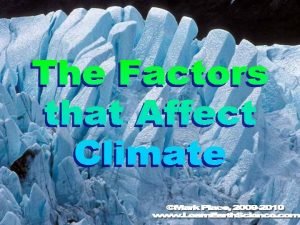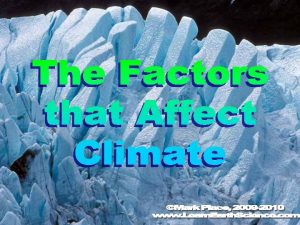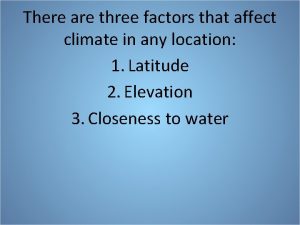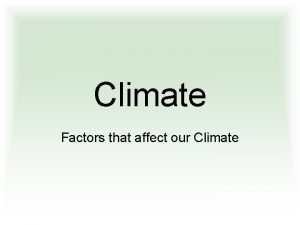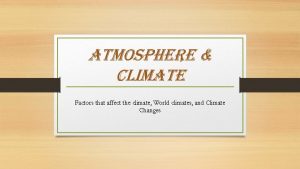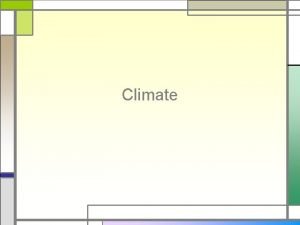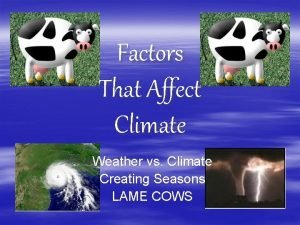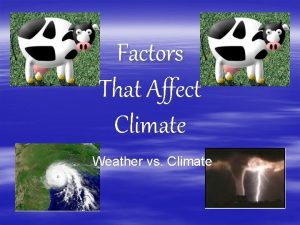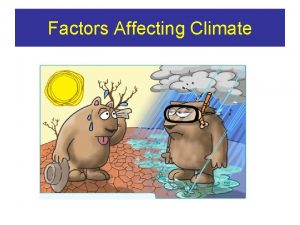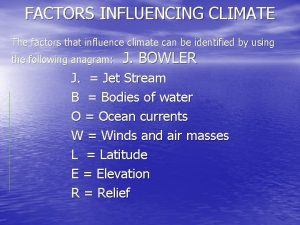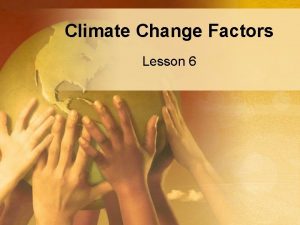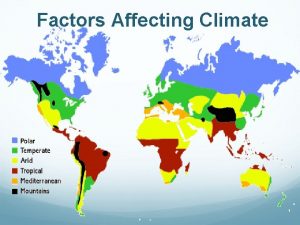What Factors Affect the Climate in Canada There

























- Slides: 25

What Factors Affect the Climate in Canada

There are 6 factors that affect climate. They are: Latitude Ocean Currents Winds and Air Masses Elevation Relief Near to Water A useful acronym to help remember these factors is : LOWER Near Water

Latitude and Climate Latitude: gives the location of a place on Earth north or south of the equator -measured in degrees Lines of Latitude: horizontal lines running east to west on a map – increase in number as you move away from equator The hottest places on Earth are found at the equator As you move AWAY from the equator (either N or S) the average temperature decreases, but the temperature range increases.

Why? The amount of energy hitting any spot on the earth is equal But, Because the earth is curved, at certain points this energy is spread out over larger distances

Therefore, Temperature decreases as you move north or south of the equator, because due to the curvature of the Earth, less light from the sun is hitting per square metre.

Ocean Currents and Climate • An ocean current is continuous, directed movement of ocean water. Temperature of the current + surrounding water = overall current temperature • Current temperature affects air temperature passing over it West coast: North Pacific current = warmer air Warm BC climate Labrador current meets Gulf stream @ Newfoundland = FOG

Therefore, Ocean currents affect climate because they influence the temperature of the air coming off the water.

Winds and Climate Using your textbook, pg 148, define the following terms: Air mass: Large volume of air that takes on climatic conditions. Wind: Movement of air from high pressure to low pressure areas. Prevailing wind: Well-established patterns of winds Polar front: Boundary between dry, polar air and warm, wet tropical air Jet stream: West to east movement of air high above polar front Because air masses take on their climatic conditions, Ocean air masses = lots of moisture + warm/cool Land air masses = very dry + warm/cool

Winds affects Climate? Air moves, High Pressure Low Pressure Creates patterns called PREVAILING WINDS In Canada, blow West (WESTERLIES) East Move air masses (affects and changes weather)

JET STREAM The east to west movement of the jet stream controls the location of the polar front. N of jet stream = COLD S of jet stream = WARM This can have MAJOR implications on weather If the jet stream shifts, there can be large shifts in temperature


Therefore, Winds affect climate by moving air masses that mimic climatic conditions, and alter the position of the jet stream

Elevation and Climate Increase in elevation = decrease in temperature Remember relief precipitation, o As air rises up, it expands and cools o. Will continue till the forming cloud becomes saturated o. Leads to increased water droplets o. Results in precipitation Rain, snow, hail

Mount Kilimanjaro in Kenya

Therefore, Increased elevation causes temperature decreases and precipitation increases

Relief and Climate Mountain barriers create relief precipitation Refer to previous day’s lesson on precipitation to clear up any problems


Therefore, The presence of mountains will cause cooler and wetter climates on windward sides and drier and warmer climates on leeward sides.

Near Water and Climate Continental Climate (Not close to body of water) Interior locations • Large temp range (hot =summer, cold =winter) • Low amounts of precipitation Maritime Climate (Close to large water body) Coastal locations • Relatively small temp range • A lot of precipitation compared to left

Therefore, The temperature range and amount of precipitation can be influenced by the proximity to a large body of water

What Climate Factor(s) is Affecting the following regions in Canada?

Cold temperatures in Artic

Dry area in B. C. interior

Fog in Newfoundland

Snow in BC mountains
 Five factors that influence climate
Five factors that influence climate Factors effecting climate change
Factors effecting climate change What factors shape the climate in canada
What factors shape the climate in canada How does wind affect weather and climate
How does wind affect weather and climate How do prevailing winds affect climate
How do prevailing winds affect climate What is lacemops
What is lacemops How does climate change affect us
How does climate change affect us What countries are in england and northwestern europe
What countries are in england and northwestern europe How did historical globalization affect canada
How did historical globalization affect canada Climate change 2014 mitigation of climate change
Climate change 2014 mitigation of climate change Regions of natural vegetation
Regions of natural vegetation Which two factors affect gravity
Which two factors affect gravity What is force
What is force Define personality psychology
Define personality psychology Infectivity definition
Infectivity definition Factors that affect housing choices
Factors that affect housing choices Factors affecting solubility product
Factors affecting solubility product Example of soluble
Example of soluble Factors that affect respiration
Factors that affect respiration Factors that affect inertia
Factors that affect inertia Factors affecting respiration
Factors affecting respiration Factors that affect food security
Factors that affect food security The nature of force
The nature of force Local factor affecting wound healing
Local factor affecting wound healing What are the factors that affect the rate of dissolution
What are the factors that affect the rate of dissolution A factor that affects the flight of a projectile is
A factor that affects the flight of a projectile is

